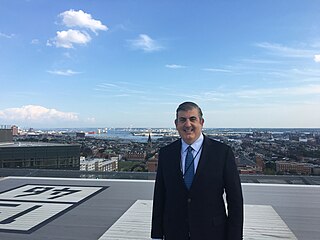Max Aebi (born 1948 in Berne) is a Swiss-Canadian spine surgeon.
Max Aebi (born 1948 in Berne) is a Swiss-Canadian spine surgeon.
Aebi is founder and former Chief of the University of Bern Spine Unit, the first academic spine unit in Switzerland. He is Chair of Orthopedic Surgery at McGill University in Montreal, Canada, and Orthopedic Surgeon-in-Chief of the McGill University Health Center.
In 1991, he co-founded the European Spine Journal where he acted as Editor-in-Chief for 23 years, and continues today as Deputy Editor of Web-Based Learning. [1] He is currently Co-Ordinating Editor of eccElearning [2] – an online spine surgery education programme.
Aebi has authored or co-authored over 250 articles, reviews, book chapters and editorials.
Max Aebi chaired the scientific advisory committee of the Cambridge-based Ranier Technology where he contributed to the development of the Cadisc-L spinal prosthesis. A much smaller customised version had been tested on monkeys in 2008. The scientific advisory committee agreed to test the implant on 30 patients. [3] The plastic discs were approved for sale by the British Standards Institution (BSI) after the completion of these tests. [3] An internal Ranier Technology report indicates that the results of the tests were analysed by the scientific advisory board. Ranier Technology was also granted CE (Conformité Européenne) safety marks for the Cadisc-L implant, as well as for another implant, Cadisc-C. [3] After the BSI and CE approval, Aebi implanted the prosthesis with 7 patients in his own practice. In March 2014, after various reports of disintegrating disks, Ranier Technology withdrew the defective prosthesis from the market. [3] In an interview on 29 November 2018, Max Aebi believed that none of his 7 patients were affected, as none of them had come forward at such time. At a later date, one of the patients alleged to have had problems with the implant. However, none of the other 7 patients had any persistent symptoms. In Germany, a case against another doctor was filed late 2018 alleging assault against 53 patients who had the device implanted. [4] In January 2023 the prosecution filed a case against Aebi alleging assault in Switzerland. [5]
Aebi spends time in humanitarian work in areas such as Pakistan and Armenia. He was involved in the rescue organisation of paralysed victims of the 2006 earthquake in Pakistan. Subsequently, he helped build the first national spine department in Pakistan, at the National Armed Forces Medical School in Rawalpindi. His work at the Pediatric Hospital in Yerevan, Armenia, has focused on spinal deformities in children, leading him to create a field study about the aetiology of congenital scoliosis. [1]
Aebi is recipient of both the AO Innovation Award, the AO Lifetime Achievement Award and the International Society for Study of the Lumbar Spine Lifetime Achievement Award. [6]
Aebi is a former president of the Spine Society of Europe and a Member of the European Academy of Sciences. [1]

Stryker Corporation is an American multinational medical technologies corporation based in Kalamazoo, Michigan. Stryker's products include implants used in joint replacement and trauma surgeries; surgical equipment and surgical navigation systems; endoscopic and communications systems; patient handling and emergency medical equipment; neurosurgical, neurovascular and spinal devices; as well as other medical device products used in a variety of medical specialties.

Orthopedic surgery or orthopedics is the branch of surgery concerned with conditions involving the musculoskeletal system. Orthopedic surgeons use both surgical and nonsurgical means to treat musculoskeletal trauma, spine diseases, sports injuries, degenerative diseases, infections, tumors, and congenital disorders.

Hip replacement is a surgical procedure in which the hip joint is replaced by a prosthetic implant, that is, a hip prosthesis. Hip replacement surgery can be performed as a total replacement or a hemi (half) replacement. Such joint replacement orthopaedic surgery is generally conducted to relieve arthritis pain or in some hip fractures. A total hip replacement consists of replacing both the acetabulum and the femoral head while hemiarthroplasty generally only replaces the femoral head. Hip replacement is one of the most common orthopaedic operations, though patient satisfaction varies widely. Approximately 58% of total hip replacements are estimated to last 25 years. The average cost of a total hip replacement in 2012 was $40,364 in the United States, and about $7,700 to $12,000 in most European countries.

The Harrington rod is a stainless steel surgical device. Historically, this rod was implanted along the spinal column to treat, among other conditions, a lateral or coronal-plane curvature of the spine, or scoliosis. Up to one million people had Harrington rods implanted for scoliosis between the early 1960s and the late 1990s.
Bone cements have been used very successfully to anchor artificial joints for more than half a century. Artificial joints are anchored with bone cement. The bone cement fills the free space between the prosthesis and the bone and plays the important role of an elastic zone. This is necessary because the human hip is acted on by approximately 10–12 times the body weight and therefore the bone cement must absorb the forces acting on the hips to ensure that the artificial implant remains in place over the long term.

The AO Foundation is a nonprofit organization dedicated to improving the care of patients with musculoskeletal injuries or pathologies and their sequelae through research, development, and education of surgeons and operating room personnel. The AO Foundation is credited with revolutionizing operative fracture treatment and pioneering the development of bone implants and instruments.

An artificial facet replacement is a joint prosthesis intended to replace the natural facets and other posterior elements of the spine, restoring normal motion while providing stabilization of spinal segments. It is typically used as an adjunct to laminectomy, laminotomy, neural decompression, and facetectomy, in lieu of standard lumbar fusion. The prosthesis is indicated for back and leg pain caused by central or lateral spinal stenosis, degenerative disease of the facets with instability, and grade 1 degenerative spondylolisthesis with objective evidence of neurological impairment.
Mayo Hospital is one of the oldest and biggest hospitals in Lahore, Punjab, Pakistan. King Edward Medical University, one of the oldest and most prestigious medical institutions in South Asia, is attached to Mayo Hospital. Mayo Hospital is located in the heart of Old Lahore, and provides free treatment to almost all admitted patients as part of a government policy. It also has many different ward's mainly centered around the Syed A route location.
Artificial disc replacement (ADR), or total disc replacement (TDR), is a type of arthroplasty. It is a surgical procedure in which degenerated intervertebral discs in the spinal column are replaced with artificial disc implants in the lumbar (lower) or cervical (upper) spine. The procedure is used to treat chronic, severe low back pain and cervical pain resulting from degenerative disc disease. Disc replacement is also an alternative intervention for symptomatic disc herniation with associated arm and hand, or leg symptoms.
Computer-assisted surgery (CAS) represents a surgical concept and set of methods, that use computer technology for surgical planning, and for guiding or performing surgical interventions. CAS is also known as computer-aided surgery, computer-assisted intervention, image-guided surgery, digital surgery and surgical navigation, but these are terms that are more or less synonymous with CAS. CAS has been a leading factor in the development of robotic surgery.
Robert S. Biscup is an American orthopaedic surgeon.

An interbody fusion cage is a prosthesis used in spinal fusion procedures to maintain foraminal height and decompression. They are cylindrical or square-shaped devices, and usually threaded. There are several varieties: the Harms cage, Ray cage, Pyramesh cage, InterFix cage, and lordotic LT cage, all of which are made from titanium; the Brantigan cage, made from carbon fibre; and the Cortical Bone Dowel, which is cut from allograft femur. The cages can be packed with autologous bone material in order to promote arthrodesis. Such implants are inserted when the space between the spinal discs is distracted, such that the implant, when threaded, is compressed like a screw. Unthreaded implants, such as the Harms and Pyramesh cages have teeth along both surfaces that bite into the end plates.
Scott Spann is an American orthopaedic surgeon, medical device inventor, former world-class swimmer and recovered quadriplegic.

Nicholas Theodore is an American neurosurgeon and researcher at Johns Hopkins University School of Medicine. He is known for his work in spinal trauma, minimally invasive surgery, robotics, and personalized medicine. He is Director of the Neurosurgical Spine Program at Johns Hopkins and Co-Director of the Carnegie Center for Surgical Innovation at Johns Hopkins.
Arthur L. Jenkins III is an American fellowship-trained neurosurgeon, co-director of the Neurosurgical Spine Program, and Director of Spinal Oncology and Minimally Invasive Spinal Surgery (MIS) Program at the Mount Sinai Hospital, New York. Additionally, he is an associate professor of Neurosurgery and of Orthopedic Surgery at the Mount Sinai School of Medicine. Dr. Jenkins has multiple patents and patent applications for spine-related implants and support systems, and is developing new minimally invasive treatments for patients with cancer that has spread to the spine. He is an innovator in the treatment of acute spinal cord injury as well as degenerative and congenital anomalies of the spine, taking a minimally invasive or minimal-impact approach where possible. He is board certified in Neurological Surgery and is licensed in New York and Connecticut.

Globus Medical, Inc. is a publicly traded medical device company headquartered in Audubon, Pennsylvania, United States. Globus is focused on the design, development, and commercialization of products that enable surgeons to promote healing in patients with musculoskeletal disorders.

Xenco Medical is an American medical technology company headquartered in San Diego, California that designs, develops, and distributes composite polymer medical devices.

NuVasive, Inc. is a medical devices company based in San Diego, California. The company primarily develops medical devices and procedures for minimally invasive spine surgery. NuVasive's products include software systems for surgical planning and monitoring, access instruments, and implantable hardware. Conditions that NuVasive products help treat are: degenerative disc disease, lumbar spinal stenosis, degenerative spondylolisthesis, cervical disc degeneration, early onset scoliosis, and limb length discrepancy.
Ralph Mobbs is an Australian neurosurgeon who specialises in spinal surgery. He operates at Prince of Wales Private and Public Hospital. He sees patients at his clinic and at an additional clinic in Bowral.

Paul Hunter Peckham is a professor of biomedical engineering and orthopedics at the Case Western Reserve University, and holds eight patents related to neural prosthetics. Peckham's research involves developing prostheses to restore function in the upper extremities for paralyzed individuals with spinal cord injury.